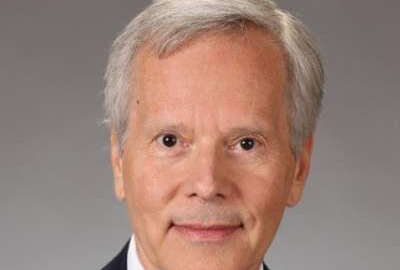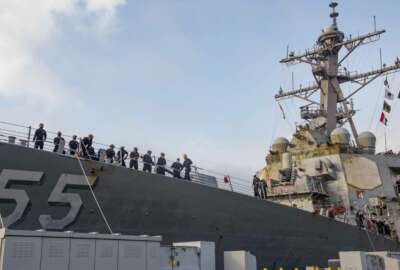
This Navy civilian engineer kept some tricky technology programs going through a tough year
The Navy recently conferred a civilian service achievement medal on an engineer at the Electro-Optic Technology Division of its Naval Surface Warfare Center.
Best listening experience is on Chrome, Firefox or Safari. Subscribe to Federal Drive’s daily audio interviews on Apple Podcasts or PodcastOne.
The Navy recently conferred a civilian service achievement medal on an engineer at the Electro-Optic Technology Division of its Naval Surface Warfare Center. Phillip Smith was cited for the quality of technical review processes and for maintaining that quality during the pandemic. Philip Smith talked with the Federal Drive with Tom Temin.
Tom Temin: Mr. Smith, good to have you on.
Philip Smith: Thanks, Tom. Good to be here.
Tom Temin: First of all, tell us what you actually do. And what does the Electro-Optic Technology Division of the Naval Surface Warfare Center do?
Philip Smith: So we are a center of excellence for full lifecycle support of electro-optic technologies, really, throughout all the services. About 50% of our work is with the Navy, we have a big chunk of work with the Army and SOCOM and a sliver that goes to the Air Force and other agencies as well. What we are primarily responsible for are really the full gamut of electro-optical systems. So that’s everything from small weapon mounted scopes, all the way up to larger turret-type electro-optic infrared type sensors that provide situational awareness as well as targeting capability from everything from the individual soldier all the way up to full US Navy combatant ships.
Tom Temin: Sure, so does that also include periscopes on submarines?
Philip Smith: So we don’t do a lot of periscope work in the division. It’s mostly surface Navy. And then again, with the other services as well, but we don’t do a lot of subsurface stuff. So mostly surface ships, airplanes as well.
Tom Temin: So your engineering expertise, then, is in what exactly?
Philip Smith: So my background is, I’m an electronics engineer. So I graduated from the University of Wisconsin with a degree in electrical engineering. And I actually spent the first part of my career doing electronic warfare, which is primarily dealing with the electromagnetic spectrum, a different part of the electromagnetic spectrum than what I work now. And what we were responsible for there was mostly RF, so radio frequency-type work, working on electromagnetic spectrum management. So we would detect signals from enemy systems to be able to locate and track where they were, as well as try to reduce our signatures and stuff that we’re doing in the Navy as well. The last two years is where I’ve kind of gotten into a new role working in electro-optics. And I’m primarily responsible from kind of a systems engineering perspective. So that’s helping establish requirements, making sure we have sound technical processes, and improving technical rigor across the division. So my position title is chief engineer, but I’m primarily responsible for processes and technical rigor in the division, making sure we do work repeatedly, that we have quality outputs, and that the products that we provide to the services are of high quality.
Tom Temin: Sure, I guess that they work and also that you can sustain them over time, because sustainment, I guess, is always the chief challenge in many of these complex systems.
Philip Smith: Yeah, we do full lifecycle support. So it’s everything from development technology, pushing the bounds of technology, developing new sensors, we do a lot of work with the electro-optics industry to push capability, give our Warfighter the advantage over their adversaries. And then we have a huge chunk of our work that is sustainment, making sure the stuff that is fielded gets fixed, it’s reliable. And it works when the warfighter counts on it.
Tom Temin: And the Civilian Service Achievement Medal, did it sort of come out of the blue? No pun intended.
Philip Smith: Yeah, it actually did. I was quite surprised when I won that, and very honored. It’s pretty exciting. So yeah, I wasn’t expecting it. I knew before the rest of the world knew, I guess, I found out about it, but it actually wasn’t much before that. So we had a small, because everything with the pandemic, everything is virtual. So we had a small command ceremony in which they presented me my award. So that was cool. And then suddenly newsletter started going out, and it got broadcast more broadly. And after that I had people reaching out to me from all over the place, congratulating me and stuff like that. So it’s pretty exciting, I’m very honored and humbled by it.
Tom Temin: And now you’re on the radio
Philip Smith: And now I’m on the radio. Yeah.
Tom Temin: We’re speaking with Philip Smith. He’s chief engineer of the Electro-Optic Technology Division of the Naval Surface Warfare Center. And what attracted you to Navy military work in the first place, coming out as a newly minted electronics engineer?
Philip Smith: I graduated actually shortly after September 11. And actually after that happened, I think like a lot of people I was trying to understand where I could serve, and I was in the throes of getting an engineering degree. And I actually contemplated for a short while joining the Army, because my family historically has always been Army people. And then I decided that I was better served, getting my engineering degree and maybe helping from a technology standpoint. So I was looking to look at civil service and where I could serve, and I found this little place in Indiana that I honestly never heard of before, but I’m from the Midwest. So [Naval Surface Warfare Center] Crane, I interviewed with them and got a job and the rest is history. So I’ve been there ever since.
Tom Temin: Yes, they have an East and a West Coast, big divisions of the Surface Warfare Center, but you don’t think of Indiana as a center for naval activity, but I guess at least in some small way it is.
Philip Smith: Yeah. And it’s actually a pretty big facility, heavily R&D, a lot of engineering work, a lot of depot-type work sustainment work, it actually is kind of a hidden gem and there’s there’s a number of warfare centers across the country, but to your point, they’re pretty much all on the coasts, with the exception of Crane.
Tom Temin: Got it. And being in the Midwest, do you ever get a chance to head to the coasts and maybe see some of the technology in action and how it’s actually deployed on ships and vessels?
Philip Smith: I definitely do. Yeah, I’ve been to a number of shipyards over the years, I’ve been underway on ships, we do a lot of installation work within the division. So once in a while, I get to go and help oversee an installation on a US Navy ship. And I’ve been on test events at sea to where we get to see the equipment and use and get to interact with the sailors. So yeah, I had the fortune of being able to travel quite a bit throughout my career.
Tom Temin: Yeah. And in this work, of course, being an Indiana and as you say, it’s a pretty large center, Crane, how did the pandemic in the telework affect the work that you were doing?
Philip Smith: For a while it was a big adjustment, because obviously the base was concerned about the spread of the disease. And wanting to social distance and make sure people stayed safe because we didn’t want the pandemic sweeping through the base and shutting down because the work we do is critical to making sure that we keep the warfighter equipped with the stuff that they need to do their jobs. And so the command was really proactive about making sure they implemented a lot of safety precautions to minimize transmission of COVID on base, and part of that was certainly a telework posture. So we started off for a while where just about everybody was teleworking. And then we started working things back where a lot of people do jobs in labs, when they have to be there, they have the state of the art test equipment and things that they have to use to do their jobs. So they went back first. And the base implemented a lot of safety precautions, cleaning all the time, we’ve got hand dispensers I think every five feet in the building. And so we were able to kind of minimize the transmission, of co-worker transmissions of the virus through that means and now we’re finally getting to a point where we’re starting to open up a little bit more and have people go back. So me personally, I was almost exclusively telework for about 12 months, I’d go in the office, maybe one day a month, if I had to, and then I would be home the rest of the time. And we were able to be quite successful at it, it was actually surprising to me how we were still able to get a lot of work done and still be able to communicate and make sure we got products out the door, despite 75% of the workforce being at home, it’s worked out really well actually.
Tom Temin: And as chief engineer, do you get to do plenty of engineering, or is it mostly managing other engineers?
Philip Smith: It’s a lot of both. I do get to get involved, not as much at the absolute bottom level. But I do get to get involved with other people’s projects and stuff and what they’re working on, and to get to review their work, help guide them towards success. And it’s honestly the most flexibile — I’ve been in this position for about two years, it’s offered me a lot of flexibility in terms of what I can get involved in. So I’ve had a lot of freedom to dive in headfirst into very specific areas as well as mentor in other areas where maybe I don’t have the expertise, or I’m not quite as specialized as some other working level engineers in the group. So it’s been a really great position, I think honestly.
Tom Temin: And by the way, whatever happened to the HP calculator?
Philip Smith: I think I still got some pretty old calculators to be honest with you. I still pull them out once in a while.
Tom Temin: All right. Philip Smith is chief engineer of the Electro-Optics Technology Division of the Naval Surface Warfare Center, and recipient of a Civilian Service Achievement Medal. Thanks so much for joining me.
Philip Smith: Yeah, thank you, Tom.
Copyright © 2025 Federal News Network. All rights reserved. This website is not intended for users located within the European Economic Area.
Tom Temin is host of the Federal Drive and has been providing insight on federal technology and management issues for more than 30 years.
Follow @tteminWFED
Related Stories





